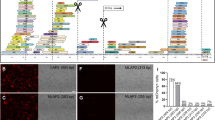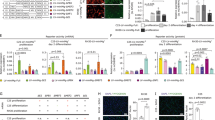Abstract
The human NCX gene, a homologue of the murine neural crest homeobox ( Ncx/Hox11L.1 ) gene whose expression is restricted to a subset of neural crest-derived tissues, was expressed in human neuroblastoma cells but not in other tumors or fibroblasts. A 4.5-kb genomic fragment in the 5′-flanking region of the NCX gene efficiently transcribed the fused luciferase reporter gene in human neuroblastoma cells but not in non-neuroblastoma cells. Sequential deletion of this regulatory region from the 5′ side demonstrated that a 1.7-kb fragment upstream from the start codon retained the preferential promoter activity in neuroblastoma cells. The transcriptional activation by the NCX promoter was stronger than that by the SV40 T antigen promoter in human neuroblastoma cells. Transfection of neuroblastoma cells with the NCX promoter–linked herpes simplex virus–thymidine kinase ( HSV-TK ) gene increased their sensitivity to ganciclovir. The regulatory region of the NCX gene is thus useful for neuroblastoma-specific suicide gene therapy. Cancer Gene Therapy (2001) 8, 997–1002
This is a preview of subscription content, access via your institution
Access options
Subscribe to this journal
Receive 12 print issues and online access
$259.00 per year
only $21.58 per issue
Buy this article
- Purchase on Springer Link
- Instant access to full article PDF
Prices may be subject to local taxes which are calculated during checkout
Similar content being viewed by others
References
Moolten FL . Drug sensitivity (“suicide”) genes for selective cancer chemotherapy Cancer Gene Ther 1994 1: 279–287
Roth JA, Cristiano RJ . Gene therapy for cancer: what have we done and where are we going? J Natl Cancer Inst 1997 88: 21–39
Miller N, Whelan J . Progress in transcriptionally targeted and regulatable vectors for genetic therapy Hum Gene Ther 1997 8: 803–815
Wen X-Y, Tang S, Breitman ML . Genetic mapping of two mouse homeobox genes, Tlx-1 andTlx-2 to murine chromosome 19 and 6 Genomics 1994 24: 388–390
Hatano M, Iitsuka Y, Yamamoto H, et al . Ncx, a Hox11 related gene, is expressed in a variety of tissues derived from neural crest cells Anat Embryol 1997 195: 419–425
Hatano M, Aoki T, Dezawa M, et al . A novel pathogenesis of megacolon in Ncx/Hox11L.1 deficient mice J Clin Invest 1997 100: 795–801
Iitsuka Y, Shimizu H, Kang MM, et al . An enhancer element for expression of the Ncx ( Enx, Hox11L1 ) gene in neural crest-derived cells J Biol Chem 1999 274: 24401–24407
Ko SC, Cheon J, Kao C, et al . Osteocalcin promoter-based toxic gene therapy for the treatment of osteosarcoma in experimental models Cancer Res 1996 56: 4614–4619
Braiden V, Nagayama Y, Iitaka M, et al . Retrovirus-mediated suicide gene/prodrug therapy targeting thyroid carcinoma using a thyroid-specific promoter Endocrinology 1998 139: 3996–3999
Arbuthnot PB, Bralet MP, Le Jossic C, et al . In vitro and in vivo hepatoma cell-specific expression of a gene transferred with an adenoviral vector Hum Gene Ther 1996 7: 1503–1514
Su H, Chang JC, Xu SM, Kan YW . Selective killing of AFP-positive hepatocellular carcinoma cells by adeno-associated virus transfer of the herpes simplex virus thymidine kinase gene Hum Gene Ther 1996 7: 463–470
Richards CA, Austin EA, Huber BE . Transcriptional regulatory sequences of carcinoembryonic antigen: identification and use with cytosine deaminase for tumor-specific gene therapy Hum Gene Ther 1995 6: 881–893
Lan KH, Kanai F, Shiratori Y, et al . In vivo selective gene expression and therapy mediated by adenoviral vectors for human carcinoembryonic antigen-producing gastric carcinoma Cancer Res 1997 57: 4279–4284
Blackwell TK, Kretzner L, Blackwood EM, et al . Sequence-specific DNA binding by the c-Myc protein Science 1990 250: 1149–1151
Whyatt DJ, deBoer E, Grosvelt F . The two zinc finger-like domains of GATA-1 have different DNA binding specificities EMBO J 1993 12: 4993–5005
Meck MM, Wierdl M, Wagner LM, et al . A virus-directed enzyme prodrug therapy approach to purging neuroblastoma cells from hematopoietic cells using adenovirus encoding rabbit carboxylesterase and CPT-11 Cancer Res 2001 61: 5083–5089
Acknowledgements
This work was supported by a grant-in-aid for scientific research from the Japan Society for the Promotion of Science, a grant-in-aid for scientific research on priority areas from the Minister of Education, Culture, Sports, Science and Technology of Japan, and the Hamaguchi foundation for the advancement of biochemistry. R. Bahar is supported by the STA fellowship from the Science and Technology Agency of Japan. We thank F. Hoffman-La Roche (Basel, Switzerland) for their generous gift of GCV.
Author information
Authors and Affiliations
Corresponding author
Rights and permissions
About this article
Cite this article
Narita, M., Bahar, R., Hatano, M. et al. Tissue-specific expression of a suicide gene for selective killing of neuroblastoma cells using a promoter region of the NCX gene. Cancer Gene Ther 8, 997–1002 (2001). https://doi.org/10.1038/sj.cgt.7700408
Received:
Published:
Issue Date:
DOI: https://doi.org/10.1038/sj.cgt.7700408
Keywords
This article is cited by
-
Neuroblastoma-specific expression of potential therapeutics cannot be achieved using a promoter region of the NCX (TLX2) gene
Cancer Gene Therapy (2010)
-
NT-polyplex: a new tool for therapeutic gene delivery to neuroblastoma tumors
Cancer Gene Therapy (2009)



